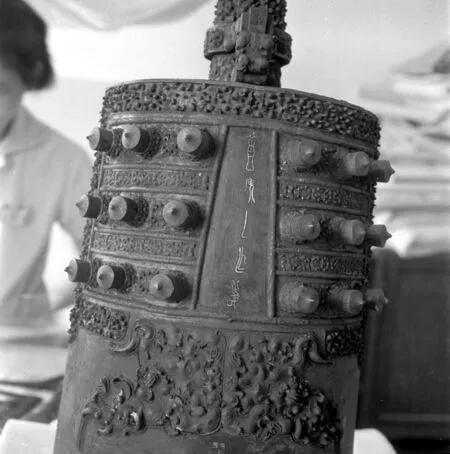Discovery and Verification of One-Bell-Dual-Tone Effect
Photos by Zhang Qijun & Su Zhuolin
曾侯乙编钟那些事9
The unearthing of the chime bells from the Tomb of Marquis Yi of Zeng created a stir across China and the world.
The audience marveled at the sight of an instrument over 2400 years old playing famous Chinese and foreign music both ancient and modern.
The 65 bells looked majestic and magnificent and even mighty as they sat perched in three rows.Filing reverently into the museum,the audience gazed at the bells with awe,hearts swelling with pride in the civilization of the great country.
曾侯乙编钟出土,惊动了中国,惊动了世界。
2400 多年前的乐器,出土之后还能演奏出古今中外名曲,听众惊讶。
65 件编钟分三层悬挂,雄壮威武奇美。博物馆里,观众面对编钟心存敬仰,为泱泱大国有此文明而骄傲自豪。
听众在演奏厅里听编钟演奏时,可能不会知道一钟双音,就算讲解员提到一钟双音,观众也不会在意,很少细究。
但我们今天要特别讲讲这一钟双音。
一钟双音,是中国先人的伟大创造,是堪与中国四大发明比肩的发现。
一钟双音的发明和应用,是中国古代乐工乐师们对世界音乐宝库的重要贡献。
武汉音乐学院副院长李幼平,在给外国听众举办的中国古典音乐讲座上说,在古代,世界各地都有钟,但它们都没有成为乐器,为什么曾侯乙编钟成了乐器,而且是一钟双音时,是这样解开奥秘的。
他说,外国人造的钟都是圆的,声音持续时间长,所以只能作为钟,而不能为乐器。唯独中国的编钟像两片瓦合在一起,声音的衰减较快,所以能编列成组,作为乐器使用。
They might have been ignorant about the double tones that rang with a bright and resonant ping from one bell when the audience listened to the bells being performed by a maestro of the instrument in the concert hall.Even if the commentator highlighted the one-bell-doubletone feature,the audience would still be clueless about its importance given their lack of knowledge on the subject.
Therefore,here we are going to give a special presentation on the one-bell-two-tone acoustic effect the chime-bells were capable of producing.
One bell with dual toneshas proven to be a great invention of the Chinese ancestors,nearly on par with their four famous inventions,namely the compass,the printing press,paper making,and gunpowder.
The invention and application of the one-bell-dual-tone effect is an important contribution of ancient Chinese musicians to the world’s stores of musical treasures.
Deputy Dean of Wuhan Conservatory of Music,Li Youping remarked in an international lecture on Chinese classical music that there were bells all over the world in ancient times,but only the Chinese variety was used as a musical instrument.Why did the Marquis Yi Chime-bells become musical instruments,and why were they double-tone bells? The following was his explanation of the mystery.
He said that the bells made abroad were round and their sound rang out for a long time,so they could only be used as clocks instead of musical instruments.Only the Chinese chime-bells were made in a unique structure like two joint tiles with an almond shape,and their sound dampened faster,so they could be arranged into groups and used as musical instruments.
The Marquis Yi Chime-bells could produce two perfect tones on one bell.This phenomenon was once perplexing,he explained.Acoustic testing found that the bells could make double tones due to their almond shape.When striking the central bottom of the bells,there were zero oscillations on the points on the left and right bottoms,and vice versa.This is how two tones can coexist in one bell without interfering with each other.
Professor Li Youping,a music archaeologist,gave an explanation that was concise and informative.However,for many years,people had naturally thought that a pre-Qin chime bell could produce only one musical tone,one single pitch.Music studies on bells,from the ancient bell-casting and live performance to modern scientific investigation and research,were long based on the understanding of one bell with one tone.
This tacit understanding had been like an absolutely still surface of water unbroken by wind or wave,and the unchallenged notion of one-bell-one-tone was “as peaceful as a mirrorlike water’s surface.” The only possible “exception” was that half a century ago,a ripple appeared on the mirror’s surface,but it disappeared immediately.
This is what Feng Jiexuan,a professor at Shanghai Customs College,said in an article commemorating the 30th anniversary of Mr.Huang Xiangpeng’s discovery of the onebell-dual-tone effect.
On perusal of Feng Jiexuan’s article,our respect for Mr.Huang Xiangpeng has doubled.
In the foregoing part of this series,it was mentioned that Huang Xiangpeng and several other experts tested the tone of the Marquis Yi Chime-bells in Suixian County and discovered the double tones on one bell.How important the result was to Huang Xiangpeng! More than a year ago,he discovered the double tone effect and wrote about it in an article that received tremendous backlash and so was never released,causing Mr.Huang to subsequently drop the subject.
The evidence that the one-belldual-tone effect of the Marquis Yi Chime-bells has garnered is so strong that it can be deemed ironclad proof.
他说,曾侯乙编钟在一个钟上能敲出两个准确的乐音,这个现象一度使人感到困惑。经声学检测发现,编钟能发双音,在于它的合瓦形状。当敲击钟的正面时,侧面的振幅为零,敲击侧面时,正面的振幅为零。这样双音共存一体,又不会互相干扰。
李幼平教授是音乐考古学家,他的讲解简明扼要。但是多年以来,人们很自然地认为先秦编钟,一钟只发一个乐音,代表一个音高。从古代铸钟、演奏实践,到现代科学考察、研究,无不以一钟一音的认识为基础。
如果把这一认识比作水面的话,那么用“水平似镜”来形容2000多年来这一状态之毫无变化,是一点也不过分的。唯一可称为“例外”的是半个世纪前,似镜的水面出现过一道涟漪,但随即消失。
这是上海海关学院教授冯洁轩在纪念黄翔鹏先生发现一钟双音30 周年文章里的话。
细读冯洁轩的文章,我们对黄翔鹏先生倍感尊敬。
上一篇故事里写到黄翔鹏与几个专家,在随县给曾侯乙编钟测音时,测出了一钟双音的结果。这一结果对黄翔鹏来说,是多么重要。因为在一年多前,他发现了一钟双音,并写出文章,但遭到多人反对,文章也未发出来,他就将此课题放下了。
曾侯乙编钟一钟双音,多么有力的证据啊!这是铁证。
2
关于一钟一音和一钟双音,我们还得从头说起。
1957年,中国河南省南部信阳市出土了一套春秋时期的编钟,中国音乐界的大腕王世襄、孟宪福、郭瑛三人前往考察,以调查小组名义发表文章。其后,杨荫浏先生也发表他的研究结果。
他们都是在一钟一音的认识基础上考察信阳编钟。
调查小组当时曾用信阳编钟演奏了《东方红》,并录了音。这次录音后来做了中央人民广播电台的开播曲。而其名声大噪,则是1970年中国发射第一颗人造地球卫星上,这曲编钟演奏的《东方红》被带上太空,不断在太空播放,响彻宇宙。
信阳出土春秋编钟共13 件,按一钟一音认识,它们只能发出13个不同音高音组成的一串音列。《东方红》乐曲中有两处出现低音区的Si 音,13 件编钟的音列中没有这个音。
为了完成录制任务,调查小组便在低音钟上各处敲敲,看能不能找出一个虽发音不纯净但音高近似低音Si 的音。
最后,他们居然在一件钟的钟枚上找到了低音Si,完成了《东方红》的录音。虽说这两处Si 音音高和音色都显得模糊,但还是对付过去了。
调查小组没有再深究为什么在一件钟的钟枚上敲出了Si 音。一钟一音的定向思维使得他们与一钟双音擦肩而过。
3
1977年3月到5月,黄翔鹏随吕骥、王湘、顾伯宝三人,到甘、陕、晋、豫四省调查。
调查中,黄翔鹏接触了许多先秦编钟,在给这些钟测音时,他注意到绝大多数钟的右鼓部有着明确的不同于正鼓部的音高,而且这两处的音程关系较有规律,基本上构成小三度。
这应该是铸钟工匠有目的地铸造的结果。
编钟在鼓部铸有鸟形图案,起着强调指明它所在部位有着另一音高音的作用,同时也成为我们认识一钟双音的目的性与规律性的有力物证。
虽然我们的祖先发明了一钟双音,并以纯熟精湛的工艺铸造出了具有明确双音的青铜编钟,实现了声乐学上的伟大发明,可随着青铜退出历史舞台,双音编钟也就被遗忘了2000 多年。
黄翔鹏在论文中首次提出了一钟双音的见解,立即遭到音乐界的质疑,人们觉得这是无法想象、不可能的事,连黄翔鹏最尊敬的前辈大家杨荫浏先生,也持完全反对的态度。
黄翔鹏在文中指出:“实际调查中,一般钟体正鼓部的内侧和左右鼓部(今称侧鼓)的内侧都有调音时留下的锉痕。可见,不仅是正鼓音经过了音高调整,而侧鼓音同样也经过了音高的调整。从而完全断定侧鼓音是古人有目地按程序在钟体上刻意铸成的另一个乐音。”
黄翔鹏以上关于一钟双音的论证是全面完整的,但杂志社把这部分删了,没有发出来,理由是文章太长,分两次发。就这样,写于1977年关于一钟双音的后半部分,直至1980年才发表在《音乐论丛》上。
As to the presumptionof onebell-one-tone and one-bell-dualtone feature,we’ll have to start from the very beginning.
In 1957,a set of chimes of the Spring and Autumn Period(770–476 BC) was unearthed in the southern part of Xinyang City of Henan Province in China,and Wang Shixiang,Meng Xianfu,and Guo Ying,all of whom were revered masters in the Chinese music industry,were sent there for a site survey and their reports were filed in the name of the investigation team.Subsequently,Mr.Yang Yinliu also published his research findings.
All of their investigations into the chimes unearthed in Xinyang was carried out on the basis of their knowledge of one bell with a single sound.
There and then the investigation team recorded the tune “The East Is Red” played with the chimes unearthed in Xinyang,which was later made the signature tune of the China National Radio.But what skyrocketed its fame was when the melody played on the chimes was taken into outer space with the first man-made satellite of China in 1970,and has since been resounding throughout the universe.
The Spring and Autumn Period chime set unearthed in Xinyang is composed of 13 bells,and was considered only capable of producing a scale of tones in 13 different pitches due to the onebell-one-tone feature.Yet,in different parts of the bass section of the song there existed two seventh“ti” tones which were absent from the 13 bells.
In order to complete the recording task,the team members played the bass chimes in search of a tone with a pitch similar to that of the bass seventh tone “ti,” even if it was not the pure tone.
In the end,they completed the recording of “The East is Red”after locating the bass seventh on a mei (a round stump-like stake protruding on the upper part of the bell body) of one of the bells.Both the pitch and timbre of these two seventh tones were somewhat indistinct,but could do in a pinch.
The team didn’t further delve into how it was possible to play a bass seventh tone on the mei of a bell.Because of their one-bell-onetone mindset,they overlooked the possibility of two tones on one bell.
From March to May in 1977,Huang Xiangpeng,together with Lü Ji,Wang Xiang,and Gu Bobao,went around to Gansu,Shaanxi,Shanxi,and Henan Provinces for investigation.
In the course of their investigation,Huang Xiangpeng examined many chime-bells cast in the pre-Qin Period.During their tone-testing of these bells,he noticed that striking the right bottom of most of the bells could produce a clear pitch different from those produced at the central bottom of the bells,and the musical interval relation between the two was fairly regular,basically forming a minor third.
It could be concluded that it was the result of the focused work of the bell-casting craftsmen.
The chimes were cast with birdshaped patterns on the bottom parts,which played the role of emphasizing that the places where they were located had another tone with a different pitch.It became powerful material evidence for us to understand the purpose and regularity of one bell with two tones.
Although our Chinese ancestors invented dual-tone bells and cast bronze chimes with clear double tones made with sophisticated craftsmanship,when bronze crafts were on their way out and vocal music was on its way up,double-tone chimes had also been forgotten for more than 2000 years.
Huang Xiangpeng first put forward his discovery on the onebell-double-tone phenomenon in his paper,which was immediately questioned by the music world.People reckoned that this was unimaginable and impossible.Even Huang Xiangpeng’s most respected
所幸的是,1978年湖北随县发掘了曾侯乙墓,出土了曾侯乙编钟,黄翔鹏等专家有幸从北京到随县为编钟测音。
黄翔鹏不仅测出了曾侯乙编钟一钟双音的结果,而且他和专家们从编钟的铭文中发现了一钟双音的记载,铭文对各个音的名称都写得清清楚楚。他百感交集,一夜之间,专家们都接受了一钟双音的事实。
有趣的是,黄翔鹏的论文下半部分发出来时,已是曾侯乙编钟一钟双音空前轰动之后,黄翔鹏的文章倒没人注意了。之后,很多文章与专论都认定曾侯乙编钟一钟双音是音乐界的伟大创举,是中国古人对世界音乐的伟大贡献。
4
说了半天黄翔鹏,还是让我们来了解一下这位终生为音乐勤奋研究奉献的音乐大家以及他的学者风范。
黄翔鹏1927年出生于江苏南京,抗日战争时就加入团结救国社从事抗日活动,1945年加入中国共产党,曾任中国艺术研究院博士生导师,《中国音乐文物大系》主编,中国音乐研究所所长。
他的研究主要在中国音乐史和中国传统音乐的理论两个领域,对出土和传世音乐文物的研究、传统音乐的型态学特征及其历史发展和中国乐律学史、曲调考证等诸方面都具有理论建树和新发现。在中国传统音乐的基础理论探索中,他提出过诸多理论。在发掘古曲、古乐发展问题和边缘学科建设,诸如音乐与声学、文物与古文献研究方面,他也有较深造诣。

The chime-bells of Marquis Yi when unearthed 编钟出土
Huang Xiangpeng pointed out in his article,“In actual investigations,generally the inner side of the central bottom of the bell bodies and those of the left and right bottom part (now called the side drums) have file marks left by tuning operations.It was apparent that the pitch of the central bottom had been retuned,along with the side drums.Thus,it can well be concluded that the side drum sound is another musical sound deliberately cast on the bell body by the ancients according to a pattern.”
Huang Xiangpeng’s argument about the double tones on one bell was comprehensive,but it was deleted during the editing of the paper by the press for the reason that the article was too long to be published entirely at one time.For this reason,it was not until 1980 that the second half about the double tones on one bell,which was written in 1977,was released in theMusic Forummagazine.
Fortunately,in 1978,Hubei Suixian County excavated the Tomb of Marquis Yi of Zeng,unearthed the chime bells,and Huang Xiangpeng and other experts made a discovery trip from Beijing to Suixian County for acoustic testing on the bells.
Huang Xiangpeng not only tested the result of the two-tone bells of Marquis Yi of Zeng,he and the other experts also discovered the records of the one-bell-doubletone effect from the inscription on the chimes.The name of each tone was clearly described in the inscription.He was overcome by a wave of emotions,and meanwhile,the experts accepted the doubletone effect in short order.
Interestingly enough,when the second half of Huang Xiangpeng’s paper was published,it failed to make much impact at all,even though it was after the dual-tone bells made such an unprecedented sensation.Later,many articles and monographs affirmed that the dual-tone chimes were a great pioneering work in the field of music and a great contribution of the ancient Chinese to world music in general.

Seal inscription on a chime-bell 编钟上的篆体铭文
With so much writtenabout Huang Xiangpeng’s great contributions,it’s time to get to know more about this great master and his scholarly style.He was a man who devoted his whole life to the study of music.
Huang Xiangpeng was born in Nanjing,Jiangsu Province in 1927.He joined the United National Salvation Association during the War of Resistance Against Japanese Aggression and engaged in national salvation activities.He joined the Communist Party of China in 1945,and was a doctoral supervisor of the Chinese Academy of Arts,chief editor of A Collection of Chinese Musical Relics,and director of the Chinese Institute of Music.
His research is mainly focused on two fields:the history of Chinese music and the theory of Chinese traditional music.He has made theoretical achievements and new discoveries in the study of the unearthed musical instruments and heritage,the morphological characteristics and historical development of traditional music,the history of Chinese musicology,and the textual research of melodies.He has put forward many theories in the exploration of the basic theory of Chinese traditional music and has profound attainments in the excavation of ancient musical instruments,the development of ancient music,and the construction of marginal disciplines,such as music and acoustics,cultural relics and ancient literature.
Huang’s wife has described him as a good man and an excellent individual with few material demands.And as a man with great inner peace,indifferent to the fame and interests of official positions,and extremely dedicated to his cause.She also extolled his sense of responsibility to her and their marriage.
From the discovery of the onebell-dual-tone effect in the pre-Qin chimes to the certification of one-bell-dual-tone feature in the Marquis Yi Chime-bells,he had only utter joy brought on for China’s contribution to the world music.During the two decades from 1977 to his departure in 1997,Huang Xiangpeng never claimed that he was the discoverer of the onebell-dual-tone effect.People have speculated that this was due to the humility and magnanimity of a highly traditional scholar,and the expression of a person who did not care about fame and wealth,only his beloved cause.In Huang Xiangpeng’s case,it is a reflection of the nobility of his character.
After Huang Xiangpeng’s departure,people in the music industry purported him to be the discoverer of the two tones on one bell,a discovery that stunned the music world.And whenever mention should be made of the one-bell-dual-tone effect,Huang Xiangpeng’s name should immediately come to mind,along with warm feelings of adoration,respect,and reverence.
(Translation:Luo Dongyuan)
黄翔鹏的妻子评价他是一个好人,一个优秀的人,一个对物质生活几乎无所求的人,一个随遇而安的人,一个对官位名利淡泊至极的人,一个对事业极端负责的人,一个对爱情婚姻极端负责的人。
从发现先秦编钟一钟双音到曾侯乙编钟证明了一钟双音,他只有喜悦,对中国给世界音乐做出贡献的喜悦。从1977年到1997年去世的20年间,黄翔鹏从未自陈过自己是一钟双音的发现者。有人说,这是传统文人的谦虚、洒脱,也是一个人不计名利、只计事业的表现,在黄翔鹏身上,这确是一种高尚人格。
黄翔鹏去世后,关于他是一钟双音的最早发现者,是由音乐界的人士说出来的。一钟双音的发现震惊世界。提到一钟双音,我们应该记住黄翔鹏。

